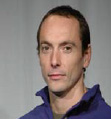|
|
|
| |
| ABSTRACT |
|
The purpose of this study was to assess the agreement and consistency between gas exchange variables measured by two online metabolic systems during an incremental exercise test. After obtaining local ethics approval and informed consent, 15 healthy subjects performed an incremental exercise test to volitional fatigue using the Bruce protocol. The Innocor (Innovision, Denmark) and CardiO2 (Medical Graphics, USA) systems were placed in series, with the Innocor mouthpiece attached to the pneumotach of the CardiO2. Metabolic data were analysed during the last 30 seconds of each stage and at peak exercise. There were non- significant differences (p > 0.05) between the two systems in estimation of oxygen consumption (VO2) and in minute ventilation (VE). Mean Cronbach’s alpha for VO2 and VE were 0.88 and 0.92. The Bland-Altman analysis revealed that limits of agreement were -0.52 to 0.55 l.min-1 for VO2, and -8.74 to 10.66 l.min-1 for VE. Carbon dioxide production (VCO2) and consequently respiratory exchange ratio (RER) measured by the Innocor were significantly lower (p < 0.05) through all stages. The CardiO2 measured fraction of expired carbon dioxide (FeCO2) significantly higher (p < 0.05). The limits of agreement for VO2 and VE are wide and unacceptable in cardio-pulmonary exercise testing. The Innocor reported VCO2 systematically lower. Therefore the Innocor and CardiO2 metabolic systems cannot be used interchangeably without affecting the diagnosis of an individual patient. Results from the present study support previous suggestion that considerable care is needed when comparing metabolic data obtained from different automated metabolic systems. |
| Key words:
Metabolic system, oxygen consumption, minute ventilation, carbon dioxide production, Bruce protocol
|
Key
Points
- There is general concern regarding the limited knowledge available about the accuracy of a number of commercially available systems.
- Demonstrated limits of agreement between key gas exchange variables (oxygen consumption and minute ventilation) as measured by the two metabolic systems were wide and unacceptable in cardio-pulmonary exercise testing.
- Considerable care is needed when comparing metabolic data obtained from different automated metabolic systems.
|
Exercise testing provides an integrative approach to different aspects of cardiovascular health (Wasserman et al., 1999). Physiologists have been interested in monitoring gas exchange variables such as oxygen consumption and carbon dioxide production over the last two centuries (Macfarlane, 2001). Technological advances today have contributed to the development of portable rapid-response breath-by-breath metabolic systems. These systems have become standard tools for diagnosing cardiorespiratory performance, not only in healthy and sporting populations, but also in those with different cardiovascular and ventilatory pathophysiological abnormalities (Hodges et al., 2005). Many automated metabolic measurement systems today present ‘black boxes’ which can generate many data without providing the user with sufficient information to evaluate exactly how the data were generated (Macfarlane, 2001). Considerable care is therefore needed when comparing metabolic data obtained from different automated metabolic systems (Hodges et al., 2005). There is general concern regarding the limited knowledge available about the accuracy of a number of commercially available systems (Carter and Jeukendrup, 2002). Different suggestions may be found in the literature about accuracy and acceptable levels of agreement between different metabolic systems. It has been suggested that minute ventilation should be accurate within ± 5% (Gore, 2000) or within ± 50 ml.min-1 (Thoden, 1991), while reported acceptable limits of agreement are -0.8 to 1.2 l.min-1 (Bassett et al., 2001). The accuracy of oxygen consumption measurements should have a technical error of measurement of less than 3% (Gore, 2000). For oxygen consumption it has been suggested that acceptable limits of agreement should be -0.08 to 0.11 l.min-1 (Bassett et al., 2001). For the purposes of the present study the limits of agreement of ± 1.2 l.min-1 for minute ventilation and ± 0.15 l.min-1 for oxygen consumption will be considered as acceptable. The purpose of this study was to assess the agreement and consistency between gas exchange variables measured by recently introduced online metabolic measuring system (Innocor, Innovision, Denmark) and an alternative online metabolic system (CardiO2, Medical Graphics, USA) during a standard incremental exercise test. SubjectsFifteen healthy adults (10 males and five females), staff and students of a South East UK University gave their signed informed consent to participate. The research was carried out in accordance with the Declaration of Helsinki and was approved by the Faculty Ethics Committee. All subjects were familiar with graded exercise testing. Subjects were asked to refrain from eating for a minimum of 2 h prior to the test and from vigorous exercise 24 hours prior to testing.
EquipmentThe Innocor (Innovision, Odense, Denmark) is a compact device intended to be used for non-invasive measurement of cardiac output using an inert gas (N2O) rebreathing methodology. It also incorporates a breath-by-breath module to measure gas exchange variables (e.g. fractions of expired O2 and CO2 (FeO2 and FeCO2), minute ventilation (VE)) and to calculate a number of derived variables (e.g. oxygen consumption (VO2), carbon dioxide production (VCO2), respiratory exchange ratio (RER)). The gas sample line and airflow umbilical are connected to the respiratory valve unit. Gas data analysis is performed and results presented by the Innocor software (version 5.05). Monitoring and presentation of the data is via the Innocor integrated computer with a Pentium MMX and Windows NT/XP embedded operating system. Measurement of airflow is performed by a pressure difference pneumotach. Carbon dioxide analysis is performed by using a photoacoustic gas analyser. Oxygen is analysed using an oxygen sensor (Oxigraf Inc., USA) based on the principle of laser diode absorption spectroscopy. Only the oxygen sensor needs 1-point calibration on a regular basis by the user while both oxygen sensor and photoacoustic gas analyser require multi-point calibration performed by manufacturer periodically (6-12 months). The manufacturer reported accuracy for measurements of ventilation ± 1%, while for O2 and CO2 concentrations ± 0.01%. The CardiO2 (Medical Graphics Corp., St Paul, MN, USA) is an automated breath-by-breath respiratory gas analysis system. The CardiO2 measures the same variables as the Innocor. However, it provides the advantage of a single, light-weight, sample line and pressure transducer umbilical. Gas analysis is performed and results presented by the BreezeSuite (version 5.0) gas exchange testing software (Medical Graphics Corporation, St. Paul, Minnesota, USA). Monitoring and presentation of the data are via a personal computer (Dell Precision 340 Pentium 4, Dell Computer Corporation, Texas, USA). Gas analysis is performed by means of Zirconia electrochemical (O2) and infrared (CO2) analysers. Airflow is measured by means of a ‘Prevent’ pitot tube flowmeter. The manufacturer of the CardiO2 reported accuracy for measurement of ventilation ± 3% or 50 ml, while for O2 and CO2 concentrations ± 0.03%. The Innocor and CardiO2 both have a gas drying sample circuit which ensures that only dry air comes into the analysers.
ProcedureAccuracy of the Innocor and CardiO2 systems for measurements of ventilation, O2 and CO2 concentrations was checked by an engineer before the study was conducted. Certified gas samples of 14-16% O2 and 3-5% CO2 were introduced into the analysers in order to check their accuracy. Minute ventilation was checked using a certified volume syringe (MedGraphics, St Paul, Minn) of 2.5 litres at a rate of 50 strokes per minute. In order to obtain simultaneous measurements the two systems were placed in series and subsequently calibrated according to the manufacturers’ recommendations before the exercise test. The gas mixtures used for the CardiO2 calibration were 5% CO2, 12% O2 in balanced N2 (calibration gas) and 21% O2 in balanced N2 (references gas). The Innocor system only requires gas delay determination (specific breathing pattern performed by user) and O2 adjustment to the ambient air prior to the test. The volume calibration was performed following the two systems were placed in series. The Innocor respiratory valve unit, with bacterial filter, was attached into the pneumotach of the CardiO2 system using a five cm flexible tube. Both systems were attached to the subject’s face mask, where the pneumotach of the CardiO2 system was closer to the subject’s mouth and the Innocor respiratory valve unit was 10 cm from the subject’s mouth (see Figure 1). Such configuration increased dead space and the distance between the subject’s mouth and the Innocor gas sensors. Before exercise testing, weight was measured using Secca scale and height on a wall-mounted stadiometer. All subjects were instructed on the use of the Borg 6-20 Rating of Perceived Exertion (RPE) scale (Borg, 1982) to ascertain their perception of effort during each test. Subjects performed an incremental exercise test to volitional fatigue on a motor driven treadmill (Cardio Control, Delft, Netherlands) using the protocol described by Bruce and colleagues (1973). Breath-by-breath metabolic data were analysed during the last 30 seconds of each stage and at peak exercise.
Data analysisAll statistical analysis was performed using SPSS version 13.0 (SPSS Inc., Chicago, IL, USA). A paired samples t-test and nonparametric Wilcoxon signed rank test were used. Statistical significance was indicated if p < 0.05. Bland-Altman plots (Bland and Altman, 1986) were constructed to assess agreement between gas exchange variables measured by the Innocor and CardiO2 systems. Bland-Altman plots included in total 72 data points (from the end of each exercise stage and from peak exercise). Cronbach’s alpha (Cronbach, 1951) was also calculated to demonstrate consistency of measures between the two systems at the end of each stage and from peak exercise. Values are expressed as means ± SD unless otherwise indicated.
Subjects were aged 34 ± 11.5 years; stature, 1.73 ± 0.11 m; weight, 71 ± 12.7 kg. All 15 subjects completed the first three stages of the Bruce protocol, while 12 subjects completed four. Table 1 presents the peak values of gas exchange variables measured by the Innocor and the CardiO2 metabolic systems. Stage by stage analysis revealed a range of differences in gas exchange variables. Oxygen consumption was not significantly different (p > 0.05) between the two systems ranging from 2% (stage one) to 6% (stage three). Cronbach’s alpha ranged from 0.80 (stage two) to 0.99 (stage one), with a mean measurement of 0.88. The mean difference in VO2 was 0.02 l.min-1 and the limits of agreement were -0.52 and 0.55 l.min-1 respectively (Figure 2). Carbon dioxide production reported by the Innocor was significantly lower than the CardiO2 throughout all exercise stages (p < 0.05, Figure 3). The differences for VCO2 ranged from 9% (stage two) to 22% (stage four). Cronbach’s alpha ranged from 0.84 (stage three) to 0.94 (stage four). The mean difference in VCO2 was -0.23 l.min-1 and the limits of agreement were -1.01 and 0.56 l.min-1 (Figure 4). Minute ventilation measurements recorded by the Innocor were higher compared with CardiO2 throughout all exercise stages except at peak exercise, ranging from 2% (stage one) to 7% (stage three). These differences were non significant (p>0.05). Cronbach’s alpha for measured VE ranged from 0.84 (stage one) to 0.98 (stage four), with a mean measurement of 0.92. Bland-Altman analysis which included data from the end of each exercise stage and from peak exercise showed that the Innocor reported higher VE values by a mean value of 0.96 l.min-1 compared with the CardiO2 and the limits of agreement of -8.74 and 10.66 l.min-1 (Figure 5). Respiratory exchange ratio estimated by the Innocor was significantly lower throughout all exercise stages (p < 0.05, Figure 6). The difference for RER ranged from 8% to 15% whilst Cronbach’s alpha ranged from 0.22 to 0.61. The mean difference in RER was -0.11 and the limits of agreement were -0.18 and 0.02. The mean differences in measured FeO2 between the two systems ranged from 2% (stage one) to 7% (stage three), and were all non-significant (p > 0.05). Cronbach’s alpha ranged from 0.64 to 0.90, dependent on the stage. The mean difference in measured FeO2 was -0.19% and the limits of agreement were -1.77 and 1.38%. FeCO2 measured by the Innocor was significantly lower compared with the CardiO2 (p < 0.01, p < 0.05) (Figure 7). The differences in measured FeCO2 ranged from 12% (stage two) to 20% (stage four), respectively. Cronbach’s alpha for FeCO2 ranged from 0.20 to 0.77, dependent on the stage. The mean difference in measured FeCO2 was -0.59% and the limits of agreement were -1.87 and 0.70%. The purpose of present study was to assess the agreement and consistency between gas exchange variables measured by the Innocor and the CardiO2 metabolic systems during an incremental exercise test. The Innocor yielded mean VO2 and VE that were not significantly different from those obtained by the CardiO2 system. The percentage VO2 differences in the present study compare favourably with findings of Porszasz et al., 1994 who reported the difference of less than 5.9% between Medical Graphics system and the Douglas bag method. Engebretson, 1998 found that the Medical Graphics system produced values of VO2 that were within 3.6% compared with the Douglas bag. Non-significant differences in mean VO2 in the present study were not surprising, although there were non-significant differences in measured FeO2 between the Innocor and CardiO2 systems. In the present study, the limits of agreement reported for VO2 of -0.52 to 0.55 l.min-1 are, however, wide and unacceptable in cardio-pulmonary exercise testing. Bassett et al., 2001 compared the ParvoMedics computerized system and Douglas bag method over a range of exercise intensities and reported that the limits of agreement of -0.08 to 0.11 l.min-1 for VO2 are acceptable. McLaughlin et al., 2001 compared the Cosmed portable metabolic system with the Douglas bag and reported wider limits of agreement (-0.33 to 0.15 l.min-1). Surprisingly, the authors concluded that the portable metabolic system is acceptable for measuring oxygen consumption. This is in spite of these limits of agreement being ~10% of the reported mean peak VO2 value of ~3.5 l.min-1. The Innocor measured VE slightly higher than the CardiO2 through all exercise stages except at peak exercise. Miles et al., 1994 showed that the Medical Graphics automated system produced the lowest VE measurement among four different metabolic systems. On the other hand Engebretson, 1998 showed no significant differences between the Medical Graphics and the Douglas bag method in measured VE, while La Mere et al., 1993 illustrated that the Medical Graphics system overestimated VE by 3.1 l.min-1 compared with the Douglas bag. Despite non-significant differences in measured VE, it should be noted that the Bland-Altman analysis indicated that the limits of agreement for VE are wide (-8.7 to 10.7 l.min-1). This is in contrast with finding of Bassett et al., 2001 who reported limits of agreement for VE of -0.8 to 1.2 l.min-1, even at higher maximum VE values than those reported in the present study (~100 l.min-1 vs. ~80 l.min-1). Individual differences in VE never exceeded 1.6 l.min-1 (Bassett et al., 2001). On the other hand, McLaughlin et al., 2001 reported wider limits of agreement for VE that were similar to those in the present study (~ -6 to 10 l.min-1). Also maximum VE was ~80 l.min-1. However, we believe that limits of agreement for VE reported in our study are wide and not acceptable in cardio-pulmonary exercise testing. As suggested, the Cronbach’s alpha coefficient should be used to indicate a degree of consistency between measurements (Cronbach, 1951). Bland and Altman, 1997 reported that the Cronbach’s alpha should be a minimum of 0.90, and 0.95 would be desirable for clinical application. The results of the present study demonstrate that high consistency exists in measured VO2 and VE between the two systems. However, the results of the present study are an obvious example that reporting only the Cronbach’s alpha without calculating the limits of agreement may lead researchers to make wrong assumptions and draw inappropriate conclusions. Both systems were calibrated and checked for their accuracy for measurements of VE, VO2 and VCO2 by an engineer before study was conducted. The report demonstrated that both systems met manufacturers’ recommendations regarding the accuracy. From manufacturers’ specifications it seems that the Innocor has capability to measure VE more accurate than the CardiO2 (± 1% vs. ± 3%). In contrast, the CardiO2 has capacity to measure O2 and CO2 concentrations with accuracy of + 0.03% compared with ± 0.01% by the Innocor. However the results from present study clearly indicate that differences in measured gas exchange variables between the two systems are higher than those suggested. When Beaver et al., 1973 compared metabolic measurements between an on-line breath-by-breath computerised system and a standard method, they suggested that differences in measured VE and VO2 may be due to temporal alignment of a gas flow or analyser dynamic response. Further potential source of error in VE and VO2 may be the method and equation used by the Innocor and the CardiO2 to estimate the BTPS factor (Hodges et al., 2005). When a subject exhales during a cardiopulmonary exercise test, the air leaves the lungs and enters the spirometer at 33-35°C (Cole, 1954). Most volume type spirometers assume instantaneous cooling of the air as it enters the spirometer, although errors can occur due to incorrect assumptions of instantaneous cooling of the air (Hodges et al., 2005). Depending on the environmental temperature, the BTPS correction factor could be as large as 10% (Crapo, 1994). As stated earlier, in order to obtain direct comparison, the two systems were placed in series. The distance of the subject to the metabolic analyser together with a bacterial filter through which air passed before reached the Innocor gas sensors may potentially affect the cooling of exhaled air. These possible differences in physical characteristics of the analysed air (e.g. temperature) may affect differences in VE and VO2 by the two systems. However, it is important to note that reversing the order of the systems, and subsequent measurement, was not possible due to equipment design. Carbon dioxide production and consequently RER values reported by the Innocor were significantly lower than those of the CardiO2. The limits of agreement for VCO2 (-1.01 and 0.56 l.min-1) were wider than those previously reported as acceptable, (e.g. -0.08 to 0.08 l.min-1, as reported by Bassett et al., 2001). These differences in VCO2 were due to lower measurements of FeCO2 by the Innocor. Although the Innocor measured VE slightly higher during all exercise stages, this was not enough to compensate for the significantly lower FeCO2 when calculating VCO2. RER values reported at peak exercise by the CardiO2 appear to be more valid than those reported by the Innocor. This indicates that the Innocor underestimated FeCO2 and VCO2 compared with the CardiO2. Miodownik et al., 2000, when comparing a newly developed semi-automated metabolic system based on a Douglas bag design and the Medical Graphics system, reported a non significant difference of 1.5% in VCO2. Engebretson, 1998 reported significantly lower VCO2 by the Medical Graphics system compared to the Douglas bag method. By contrast, few studies have reported non significant differences in measured VCO2 between the Medical Graphics systems and the Douglas bag method (Porszasz et al., 1994; Prieur et al., 1998), while Miles et al., 1994 reported that the Medical Graphics system measured a higher VCO2 compared with three other metabolic systems. It is accepted that an increased dead space and the distance between the Innocor sensors and the subject’s mouth, may have contributed to the poor consistency and agreement in measured FeCO2 and VCO2. Analysing RER results at peak exercise it seems that this direct comparison study design may possibly affect more the Innocor CO2 sensors than those in the CardiO2. An additional problem is that of correcting water vapour pressure in the expired air, as this pressure may be quite different to that in the calibration gas (Davies et al., 1974). Although the gas analysers were adjusted automatically to ignore the contribution of water vapour (effectively measuring dry air), most CO2 analysers are sensitive to the presence of water vapour (Macfarlane, 2001). As the dead space was increased in the present study, this could potentially enhance higher water condensation, and possibly effect CO2 analysers and measurement of FeCO2. Therefore the possible inability of infrared sensors to cope with the water vapour could have contributed to the discrepancies in measured FeCO2. The possible measurement of the temperature of the sample near the flow detector followed by calculation and correction according to the absolute water vapour pressure could possible identify the source of error. However, the measurement of the temperature was not possible due to direct comparison study design and specific configuration of the Innocor respiratory valve unit where the sensors are located. Lower FeCO2 measured by the Innocor may be due to lower response time of the analyser. This particularly may be emphasized with higher breathing frequencies at higher intensity of exercise. Supporting this assumption Figure 3 demonstrates that the difference in VCO2 was higher at the end of stage four than at the end of previous stages of the Bruce protocol. There is evidence to suggest the use of different algorithms for correcting response time (Ariely and Van Liew, 1981; Farmery and Hahn, 2000). Farmery and Hahn, using specific correcting methods, were able to reduce response times for measured gases almost fivefold. Therefore future investigations should evaluate the use of suggested algorithms for correcting the response time not only in the most commonly used metabolic analysers but also in those which have recently appeared. Finally, the differences in measured CO2 between the two systems may be explained by the technological factors. The Innocor uses a newly developed portable multigas analyser which uses the principle of photoacoustic spectroscopy with an infrared spectrum, while the CardiO2 uses a standard non-dispersive infrared CO2 sensor. The results of this study revealed that the Innocor produces similar mean values of VO2 and VE to those obtained from the CardiO2 system. However, the limits of agreement for VO2 and VE were wide and unacceptable in cardio-pulmonary exercise testing. Also, the data from the present study suggest that systematic bias exists in measured FeCO2 and VCO2. Therefore the Innocor and CardiO2 metabolic systems cannot be used interchangeably without affecting the diagnosis of an individual patient. Results from the present study support previous suggestion that considerable care is needed when comparing metabolic data obtained from different automated metabolic systems.
| ACKNOWLEDGEMENTS |
The authors have no financial or business interests in any of the companies mentioned in this article. |
|
| AUTHOR BIOGRAPHY |
|
 |
Djordje G. Jakovljevic |
| Employment: PhD student, Research Centre for Society and Health, Buckinghamshire New University, United Kingdom. |
| Degree: MSc, BSc |
| Research interests: Exercise physiology in health and disease (heart failure) particularly focusing on overall cardiac function as represented by cardiac power output. |
| E-mail: djordje.jakovljevic@bcuc.ac.uk |
| |
 |
David Nunan |
| Employment: PhD student, Research Centre for Society and Health, Buckinghamshire New University, United Kingdom. |
| Degree: MSc, BSc |
| Research interests: Cardiovascular and autonomic health in heart failure patients; physical activity and recovery; exercise physiology. |
| E-mail: dnunan01@bcuc.ac.uk |
| |
 |
Gay Donovan |
| Employment: PhD student, Research Centre for Society and Health, Buckinghamshire New University, United Kingdom. |
| Degree: MSc, BSc |
| Research interests: Exercise physiology in health and disease (heart failure), particularly focusing on heart rate and metabolic recovery following exercise. |
| E-mail: gcarpu01@bcuc.ac.uk |
| |
 |
Lynette D. Hodges |
| Employment: Senior Lab Manager, Department of Sport and Exercise Science, University of Bedfordshire, United Kingdom. |
| Degree: PhD |
| Research interests: Erectile dysfunction; exercise benefits for people with cardiovascular disease, especially peripheral vascular disease. |
| E-mail: lynette.sigleton@beds.ac.uk |
| |
 |
Gavin R. H. Sandercock |
| Employment: Lecturer in Clinical Exercise Physiology, Centre for Sports and Exercise Science, University of Essex, United Kingdom. |
| Degree: PhD |
| Research interests: Cardiac autonomic function; cadiovascular disease prevention and rehabilitation. |
| E-mail: gavins@essex.ac.uk |
| |
 |
David A. Brodie |
| Employment: Professor of Cardiovascular Health and Head of Research, Buckinghamshire New University, United Kingdom. |
| Degree: PhD |
| Research interests: Cardiovascular health as applied to healthy and unhealthy populations (eg heart failure patients); cardiac rehabilitation; erectile dysfunction. |
| E-mail: david.brodie@bcuc.ac.uk |
| |
|
| |
| REFERENCES |
 Ariely R., Van Liew H. D. (1981) Correction for the response time and delay of mass spectrometers. Journal of Applied Physiology 51, 1417-1422. |
 Bassett D.R., Howley E.T., Thompson D.L., King G.A., Strath S.J., McLaughlin J.E., Parr B.B. (2001) Validity of inspiratory and expiratory methods of measuring gas exchange with computerized system. Journal of Applied Physiology 91, 218-224. |
 Beaver W.L., Wasserman K., Whipp B.J. (1973) On-line computer analysis and breath-by-breath graphical display of exercise function tests. Journal of Applied Physiology 34, 128-132. |
 Bland M.J., Altman D.G. (1986) Statistical methods for assessing agreement between two methods of clinical measurements. Lancet 1, 307-310. |
 Bland M.J., Altman D.G. (1997) Statistics notes: Cronbach’s alpha. British Medical Journal 314, 572-573. |
 Borg G. (1982) Psychophysical bases of perceived exertion. Medicine and Science in Sports Exercise 14, 377-381. |
 Bruce R.A., Kusumi F., Hosmer D. (1973) Maximal oxygen intake and nomographic assessment of functional aerobic impairment in cardiovascular disease. American Heart Journal 85, 546-542. |
 Carter J., Jeukendrup A.E. (2002) Validity and reliability of three commercially available breath-by-breath respiratory systems. European Journal Applied Physiolology 86, 435-441. |
 Cole P. (1954) Recording of respiratory air temperature. Journal of Laryngology 68, 295-307. |
 Crapo R.O. (1994) Standardisaton of spirometry. Medical section of the lung Association. American Journal of Respiratory Care 152, 1107-1136. |
 Cronbach L.J. (1951) Coefficient alpha and the internal structure of tests. Psychometrika 16, 297-334. |
 Davies E.E., Hahn H.L., Spiro S.G., Edwards R.H. (1974) New technique for recording respiratory transients at the start of exercise. Respiratory Physiology 20, 69-79. |
 Engebretson J.E. (1998) Validity of a breath by breath gas exchange analysis system. Medicine and Science in Sports and Exercise 30, S330-. |
 Farmery A.D., Hahn C.E.W. (2000) Response-time enhancement of a clinical gas analyzer facilitates measurement of breath-by-breath gas exchange. Journal of Applied Physiology 89, 581-598. |
 Gore C.J., Gore C.J. (2000) Physiological Testing for Elite Athletes. Quality assurance in exercise physiology laboratories. Champaign (IL). Human Kinetics.. |
 Hodges L.D., Brodie D.A., Bromley P.D. (2005) Validity and reliability of selected commercially available metabolic analyzer systems. Scandinavian Journal of Medicine and Science in Sport 15, 271-279. |
 La Mere V.J., Brown K., Wigglesworth J.K., Edwards J.E. (1993) Reproducibility between three metabolic systems and validation by Douglas bag method. Medicine and Science in Sports and Exercise 25, S9-. |
 Macfarlane D.J. (2001) Automated metabolic gas analysis systems. Sports Medicine 31, 841-861. |
 McLaughlin J.E., King G.A., Howley E.T., Bassett D.R., Ainsworh B.E. (2001) Validation of the Cosmed K4 b2 portable metabolic system. International Journal of Sports Medicine 22, 280-284. |
 Miles D.S., Cox M.H., Verde T.J. (1994) Four commonly utilized metabolic systems fail to produce similar results during submaximal and maximal exercise. Sports Medicine Training and Rehabilitation 5, 189-198. |
 Miodownik S., Carlon V.A., Ferri E., Burda B., Melendez J.A. (2000) System of automated gas-exchange analysis for the investigation of metabolic processes. Journal of Applied Physiology 89, 373-378. |
 Porszasz J., Barstow J., Wasserman K. (1994) Evaluation of a symmetrically disposed Pitot tube flowmeter for measuring gas flow during exercise. Journal of Applied Physiology 77, 2659-2665. |
 Prieur F., Busso T., Castells J., Bonnefoy R., Benoit H., Geyssant A., Denis C. (1998) Validity of oxygen uptake measurements during exercise under moderate hyperoxia. Medicine and Science in Sports and Exercise 36, 958-962. |
 Thoden J.S., MacDougall J.D., Wenger H.A., Green H.I. (1991) Physiological Testing of the High Performance Athlete. Testing aerobic power. Champaign (IL). Human Kinetics. |
 Wasserman K., Hansen J.E., Sue D.Y., Casaburi R., Whipp B.J. (1999) Principles of Exercise Testing and Interpretation. Baltimore. Williams and Wilkins. |
|
| |
|
|
|
|

